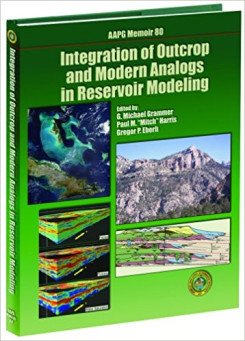Integration of Outcrop and Modern Analogs in Reservoir Modeling
Building robust 3-D reservoir models is a major challenge that requires incorporation of geologically defined input parameters. This publication provides an overview of current approaches used in the development of geologically constrained and integrated reservoir models.
Each of the 18 papers addresses various stages in the process of creating a reservoir model through the development and incorporation of an analog, extracting the quantitative input parameters on lateral and vertical variability, and the development and modification of a 3-D reservoir model based upon geologically constrained data.
This applied volume is divided into two sections. The first is a set of papers illustrating the value and methodology of acquiring geometrical data on the lateral and vertical distribution of reservoir facies, within a sequence stratigraphic framework, using both outcrop analogs and detailed study of modern depositional systems. The second section includes both case studies where outcrop and modern analog data have been incorporated into subsurface reservoir models, as well as papers that illustrate recent advances in simulation and geostatistical methodologies. Together, the two sections provide a comprehensive look at integrated reservoir modeling.
Cast & Characters
| 1-22 | Integration of Outcrop and Modern Analogs in Reservoir Modeling: Overview with Examples from the Bahamas |
| 23-44 | Depositional Themes of Mixed Carbonate-siliciclastics in the South Florida Neogene: Application to Ancient Deposits |
| 45-66 | Predicting Tidal Sand Reservoir Architecture Using Data from Modern and Ancient Depositional Systems |
| 67-92 | Sequence-stratigraphic and Paleogeographic Distribution of Reservoir-quality Dolomite, Madison Formation, Wyoming and Montana |
| 93-108 | A Laterally Accreting Grainstone Margin from the Albian of Northern Mexico: Outcrop Model for Cretaceous Carbonate Reservoirs |
| 109-128 | An Upper Mississippian Carbonate Ramp System from the Pedregosa Basin, Southwestern New Mexico, U.S.A.: An Outcrop Analog for Middle Carboniferous Carbonate Reservoirs |
| 129-152 | Sedimentology, Statistics, and Flow Behavior for a Tide-influenced Deltaic Sandstone, Frontier Formation, Wyoming, United States |
| 153-170 | A Comparison of Two Early Miocene Carbonate Margins: The Zhujiang Carbonate Platform (Subsurface, South China Sea) and the Pirinç Platform (Outcrop, Southern Turkey) |
| 171-190 | Accommodation-controlled Systems-tract–specific Facies Partitioning and Resulting Geometric Development of Reservoir Grainstone Ramp-crest Shoal Bodies |
| 191-214 | Reservoir Characterization in the San Andres Formation of Vacuum Field, Lea County, New Mexico: Another Use of the San Andres Algerita Outcrop Model for Improved Reservoir Description |
| 215-234 | An Integrated Approach to Characterization and Modeling of Deep-water Reservoirs, Diana Field, Western Gulf of Mexico |
| 235-260 | Outcrop-based Three-dimensional Modeling of the Tensleep Sandstone at Alkali Creek, Bighorn Basin, Wyoming |
| 261-278 | Integration of High-resolution Outcrop and Subsurface Data to Enhance Interpretation of Low-resolution Seismic Data in the Upper Devonian (Frasnian) Carbonate System in Western Canada |
| 279-308 | Well Placement, Cost Reduction, and Increased Production Using Reservoir Models Based on Outcrop, Core, Well-log, Seismic Data, and Modern Analogs: Onshore and Offshore Western Trinidad |
| 309-336 | Integrating Sequence Stratigraphy and Multiple Three-dimensional Geostatistical Realizations in Constructing a Model of the Second Eocene Reservoir, Wafra Field, Partitioned Neutral Zone, Kuwait and Saudi Arabia |
| 337-364 | Outcrop and Waterflood Simulation Modeling of the 100-Foot Channel Complex, Texas, and the Ainsa II Channel Complex, Spain: Analogs to Multistory and Multilateral Channelized Slope Reservoirs |
| 365-382 | Computer Simulation of Carbonate Sedimentary and Shallow Diagenetic Processes |
| 383-394 | Multiple-point Geostatistics: A Quantitative Vehicle for Integrating Geologic Analogs into Multiple Reservoir Models |

